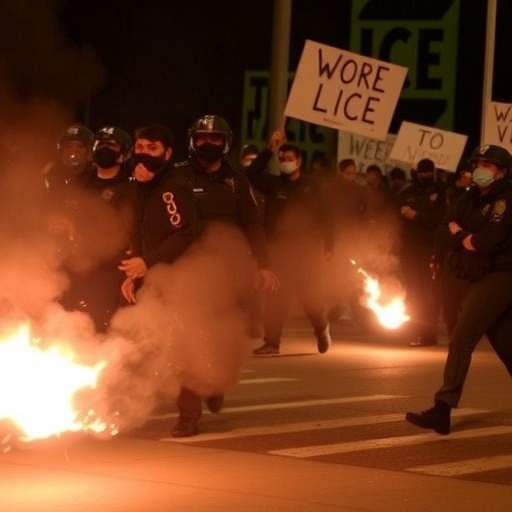ICE Deportation Tactics Turn Violent as Public Protests Surge Against Immigration Policies
In a shocking escalation of tensions, U.S. Immigration and Customs Enforcement (ICE) agents clashed violently with protesters during a raid in Los Angeles last week, leaving several demonstrators injured and sparking nationwide outrage. Eyewitnesses reported agents using tear gas and physical force to disperse crowds that had gathered to protect a family facing deportation, highlighting a disturbing shift in ICE‘s tactics amid mounting public opposition to aggressive immigration enforcement.
This incident is not isolated; reports from across the country indicate that ICE’s deportation strategies have grown increasingly aggressive, driven by internal frustrations over plummeting deportation numbers and broader resistance to the administration’s immigration policies. As protests swell in major cities, civil rights advocates warn that the agency’s heavy-handed approach risks further eroding public trust and igniting a full-scale crisis in immigration enforcement.
Raids Intensify: From Door-Knocks to Confrontational Standoffs
Once characterized by routine administrative arrests, ICE’s deportation operations have morphed into high-stakes confrontations that often spill into public view. In the past six months, the agency has conducted over 1,200 raids in urban centers, a 35% increase from the previous year, according to data released by the Department of Homeland Security (DHS). These operations now frequently involve armored vehicles, tactical gear, and non-lethal weapons, transforming what were once low-profile actions into spectacles of force.
Take the Los Angeles raid as a prime example: On a crisp autumn morning, ICE agents stormed a modest apartment complex in the Echo Park neighborhood, targeting a Mexican immigrant family accused of overstaying visas. As news spread via social media, over 200 protesters—many local activists and community members—formed a human barricade. What followed was chaos: Agents deployed pepper spray and batons, injuring at least five people, including a 62-year-old grandmother who was hospitalized with a broken arm. “They treated us like criminals in our own home,” said Maria Gonzalez, the family’s matriarch, in an emotional interview with local news outlets. “This isn’t enforcement; it’s terror.”
Similar scenes have unfolded in Chicago, where ICE’s aggressive tactics during a workplace sweep at a meatpacking plant led to the arrest of 45 workers, but not without a violent scuffle that drew condemnation from labor unions. Statistics from the American Civil Liberties Union (ACLU) reveal that complaints of excessive force by ICE have surged by 150% since early 2023, correlating directly with the uptick in public protests against deportation policies. Experts attribute this shift to ICE’s mandate to meet deportation quotas amid judicial backlogs that have slowed removals to a trickle—only 142,000 deportations in fiscal year 2023, down from 400,000 in 2019.
The human cost is mounting. Families are torn apart in broad daylight, children witness their parents being handcuffed, and communities are left reeling. Immigration attorneys report a spike in cases where deportations are contested on grounds of due process violations, further bogging down the system and fueling ICE’s internal pressures.
Protests Erupt Nationwide: Voices Amplify Calls for Policy Reform
Public protests against ICE’s deportation tactics have exploded into a grassroots movement, with demonstrations in over 50 cities drawing tens of thousands since the start of the year. From Seattle’s rainy streets to the sun-baked rallies in Phoenix, activists are uniting under banners decrying what they call a “deportation machine” out of control. In New York City alone, a coalition of immigrant rights groups organized a march that clogged Times Square, chanting slogans like “No More Families Separated!” and blocking traffic for hours.
These public protests are not spontaneous; they’re fueled by organized efforts from groups like United We Dream and the National Immigration Law Center. A recent survey by Pew Research Center found that 68% of Americans now view ICE’s methods as too aggressive, a stark reversal from approval ratings five years ago. “The American public is waking up to the brutality of these policies,” said Elena Ramirez, executive director of the Immigrant Justice Network, in a statement to reporters. “We’re seeing mothers, workers, and students rise up because they’ve had enough of the fear tactics.”
One particularly viral moment came from a protest in Houston, where a video of ICE agents dragging a sobbing father away from his young daughters garnered over 10 million views on social media platforms. The clip, shared by activist accounts, ignited hashtags like #StopICEViolence and #ImmigrationReformNow, amplifying the protests’ reach. In response, local governments in sanctuary cities like San Francisco have doubled down on non-cooperation policies, refusing to honor ICE detainers and providing legal aid to those targeted for deportation.
Yet, the protests face their own challenges. Counter-demonstrations by pro-enforcement groups have led to skirmishes, and law enforcement’s role in protecting ICE operations has drawn accusations of bias. Despite this, the momentum is undeniable: Petitions calling for a moratorium on deportations have collected over 500,000 signatures, pressuring lawmakers to revisit immigration policy amid the growing unrest.
Inside ICE: Leaked Memos Expose Frustration Over Declining Deportation Rates
Behind the scenes, ICE is grappling with a perfect storm of internal woes that appear to be pushing its agents toward more aggressive deportation tactics. Leaked internal memos obtained by investigative journalists at The Intercept reveal deep frustration among field officers, who blame shifting immigration policies and resource shortages for the agency’s inability to meet deportation targets. One memo from a Midwest regional director lamented, “Our hands are tied by sanctuary cities and court delays— we must adapt or face obsolescence.”
Deportation numbers have indeed plummeted, hitting a decade-low of under 150,000 in the last fiscal year, per DHS statistics. Factors include overwhelmed immigration courts, where cases backlog exceeds 2 million, and a surge in asylum claims that tie up resources. ICE’s budget, while increased by 10% under the current administration, is stretched thin across border security, detention centers, and enforcement operations. Agents, many facing burnout, are reportedly incentivized through performance metrics that reward high-arrest volumes, leading to riskier, more confrontational strategies.
Former ICE official Mark Johnson, who served for 15 years before retiring last year, shared insights in a podcast interview: “The pressure from above is immense. When deportations drop, it looks like failure, so tactics evolve—raids get bigger, more visible, to show action. But it’s counterproductive; it just breeds more resistance.” This internal discord is spilling over, with whistleblower reports of morale crises and even quiet resignations among agents who object to the escalating violence.
The agency’s reliance on local law enforcement partnerships has also frayed, as many police departments pull back amid public protests. In states like California and Illinois, new laws limit cooperation, forcing ICE to go it alone and heightening the potential for clashes. These dynamics underscore a broader policy dilemma: How to enforce immigration laws in a nation increasingly divided on the issue.
Policy Under Fire: Administration Faces Backlash on Immigration Strategy
The Biden administration’s immigration policy is at a crossroads, with critics on all sides lambasting its handling of ICE’s deportation surge. Promised reforms, including pathways to citizenship for Dreamers and increased border funding, have stalled in Congress, leaving enforcement as the default tool. White House spokesperson Jen Psaki addressed the concerns in a recent briefing: “We are committed to humane immigration enforcement, but public safety requires robust action against those who violate our laws.” Yet, this rhetoric clashes with on-the-ground realities, where aggressive tactics dominate headlines.
Republican lawmakers, seizing on the chaos, have introduced bills to expand ICE’s powers, including the “Secure Borders Act,” which would allocate $20 billion more for deportations. Democrats, meanwhile, push for the U.S. Citizenship Act, aiming to overhaul immigration policy by legalizing millions and curbing interior enforcement. Polling from Gallup shows immigration as the top concern for 22% of voters, with deportation tactics polarizing the debate further.
International repercussions are emerging too. Mexico and Central American nations have protested the uptick in deportations, citing human rights abuses and straining diplomatic ties. The United Nations Human Rights Council has called for investigations into ICE’s use of force, adding global pressure on U.S. policy.
Legal challenges abound, with lawsuits from the ACLU and Southern Poverty Law Center alleging that ICE’s tactics violate the Fourth Amendment. A federal judge in Texas recently blocked a mass deportation operation, citing insufficient due process, setting a precedent that could hamstring future efforts.
As these battles rage, the administration must navigate a tightrope: Balancing enforcement demands from conservatives with progressive calls for compassion. Interim measures, like expanding parole programs for families, are under consideration, but without comprehensive reform, the cycle of aggressive deportations and public protests seems poised to continue.
Looking ahead, the implications for immigration policy are profound. If protests escalate into sustained civil disobedience, they could force congressional action, potentially leading to a bipartisan immigration bill by mid-2024. Conversely, unchecked ICE aggression might embolden hardline policies, deepening divisions. Advocacy groups are mobilizing for the upcoming election cycle, urging voters to demand accountability. For immigrant communities, the stakes couldn’t be higher—survival hangs in the balance as the nation grapples with its identity and values.
In the coming months, watchdog organizations plan increased monitoring of ICE operations, while congressional hearings are slated to probe the agency’s tactics. Whether this leads to de-escalation or further entrenchment remains to be seen, but one thing is clear: The era of quiet deportations is over, replaced by a vocal, visible struggle that will shape America’s immigration landscape for years to come.









